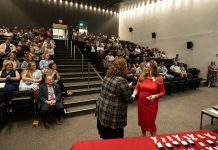A key stop on the Columbus Area Visitors Center architectural walking tour includes a new enhancement that helps tell the story of the city’s longtime architectural, business and philanthropic leader.
A six-panel timeline of the late J. Irwin Miller and the Irwin-Sweeney-Miller family, consisting mostly of photos and graphics, will be unveiled at a special ribbon-cutting and open house May 24 in part of the offices at 301 Washington St., according to local tourism officials.
The stop has been a notable one for about five years on the walking tour.
Bonnie Boatwright, a visitors center employee who leads some of the tours, said she thinks visitors will enjoy the time capsule.
[sc:text-divider text-divider-title=”Story continues below gallery” ]
Miller worked from a second-floor office at 301 in downtown Columbus from his early days with Cummins and Irwin Union Bank and Trust Co., and his early leadership of the Irwin-Sweeney-Miller Foundation, until shortly before his death in 2004.
Besides serving as leader of Cummins for decades — he began as general manager in 1934 — and serving as the catalyst and leading supporter of the city’s top-notch architectural program for public buildings from schools to churches, Miller also served as an adviser to several U.S. presidents.
Plus, he won the attention and respect of such national leaders as the Rev. Martin Luther King because of his strong human and civil rights beliefs.
The Victorian-style 301 building itself, dating to 1848 and now owned by Cummins, also is a community cornerstone where Joseph Irwin and son W.G. Irwin launched the Inter-Urban Railroad; where W.G. Irwin helped Cummins’ co-founder Clessie Cummins financially launch and continue the now-worldwide diesel engine firm that marks the city; and where a family foundation bestowed millions of dollars for a myriad of projects and causes enriching the lives of thousands.
Karen Niverson, the visitors center executive director, suggested the first-floor addition, which will soon get a seventh panel featuring an Irwin-Sweeney-Miller family tree. Work on the effort began informally with meetings last summer.
“In my mind, 301 Washington St. is Ground Zero, not only for all the corporate and architectural work that J. Irwin Miller did, but also for his philanthropic endeavors,” Niverson said. “It helps tell the whole story, and it takes us back to where it all happened.”
Niverson complimented Columbus Indiana Architectural Archives’ curator and archivist Tricia Gilson and others working on the visitors center project for taking “an epic story and honing it down to something that people can absorb quickly.”
That’s especially important since the office constitutes only a 10-minute stop on the quick-hit highlights of the overall 90-minute walking tour. Among the most striking features of Don Nissen’s greenish, gold and magenta layout — one with colors that match famed designer Alexander Girard’s drapes in the first-floor space — is a warm, black-and-white 1940s-era photo of a relaxed, beaming and young J. Irwin and Xenia Miller on vacation.
“We most often see them both in a more formal and structured setting,” Gilson said. “It’s among the few photos that I have seen of them that feels quite candid.”
Sarla Kalsi, who helped with the project because she served as executive director of the Irwin-Sweeney-Miller Foundation that was housed for years in the Washington Street location, understood as well as anyone that Miller never drew attention to himself for his own sake.
As an example, he and his wife, Xenia Miller, ideally asked that their names be left off the original Commons that they and J. Irwin Miller’s sister Clementine Tangeman gifted to the community in 1973. Still, a small placard bearing their three names was placed in the structure.
“Over the years, friends would come here to see him,” Kalsi said of J. Irwin Miller. “And they wanted to see his house (designed by friend and world-renowned architect Eero Saarinen), and they wanted to see his office. And he loved to show those to them.”
[sc:pullout-title pullout-title=”Telling the story at 301″ ][sc:pullout-text-begin]
What: Newly installed timeline panels of the Irwin-Sweeney-Miller family history and especially that of J. Irwin Miller in Columbus.
Where: Part of the offices at 301 Washington St. in downtown Columbus.
When: Columbus Area Visitors Center has organized a ribbon-cutting with the Columbus Area Chamber of Commerce at 4:30 p.m. May 24 with an open house until 6 p.m.
Why the space is important: It functioned as the longtime office of J. Irwin Miller, decades-long leader of Cummins Engine Co., Irwin Union Bank and Trust Co., philanthropist and founder of the local public architecture program.
[sc:pullout-text-end]




